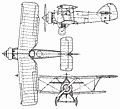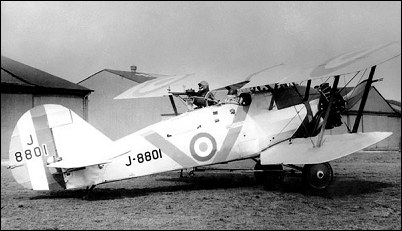|
| In its original prototype form the Armstrong Whitworth Atlas flew for the first time on 10 May 1925. This was a somewhat larger and heavier sesquiplane than the Siskin, which had preceded it on the production line. It had been designed big (to accommodate essential equipment) and strong (to stand up to punishment) to meet the RAF's requirement for an army cooperation aircraft. The Atlas was, in fact, the first aircraft designed for the RAF for this specific role, which, prior to its entry into service, had been filled by aircraft adapted for the purpose.
It was not until nearly 2 years after the prototype's first flight that this two-seat aircraft began to enter squadron service. In the interim period the company had used innumerable 'try-it-and-see' ideas to overcome shortcomings in flight characteristics revealed by service testing. Thus came changes in wing dihedral, incidence and sweepback, the provision of new wings, automatic wingtip slots and, in the case of aircraft
for the RCAF, the addition of ailerons on the lower wings. In the long term this effort was worthwhile, for a total of more than 440 were built for the RAF, of which 175 were dual-control advanced trainers. These aircraft were to remain in service until 1934 in the army cooperation role, and as advanced trainers and communications aircraft into 1935. In addition to those built for the RAF, small numbers were exported to Canada, Egypt, Greece and Japan. By no means a great aeroplane, the Atlas was renowned for its rugged reliability and benefited from use of the reliable and developed Jaguar IVC power plant in the Atlas Mk I, and the improved 399kW Panther IIA in the Mk II version. Equipment included radio, message pick-up hook and cameras.
 | A three-view drawing (676 x 638) |
| MODEL | Atlas Mk I |
| ENGINE | 1 x Armstrong Siddeley Jaguar IVC, 298kW |
| WEIGHTS |
| Take-off weight | 1823 kg | 4019 lb |
| DIMENSIONS |
| Wingspan | 12.06 m | 40 ft 7 in |
| Length | 8.71 m | 29 ft 7 in |
| PERFORMANCE |
| Max. speed | 230 km/h | 143 mph |
| Range | 770 km | 478 miles |
| ARMAMENT | 2 x 7.7mm machine-guns, 4 x 50kg bombs |
 | A three-view drawing of Atlas Mk I (900 x 814) |
| Bernard Rumbold, e-mail, 20.04.2014 04:23 operated by XIII Sqn RAF at Andover from 1925 - 1929 reply | | beifan, 21.06.2011 07:14 Equipment included radio, message pick-up hook and cameras. reply | | Graeme, 29.11.2008 02:08 Your 3-view depicts the Atlas II reply |
|
Do you have any comments?
|
| 
COMPANY
PROFILE
All the World's Rotorcraft
|









